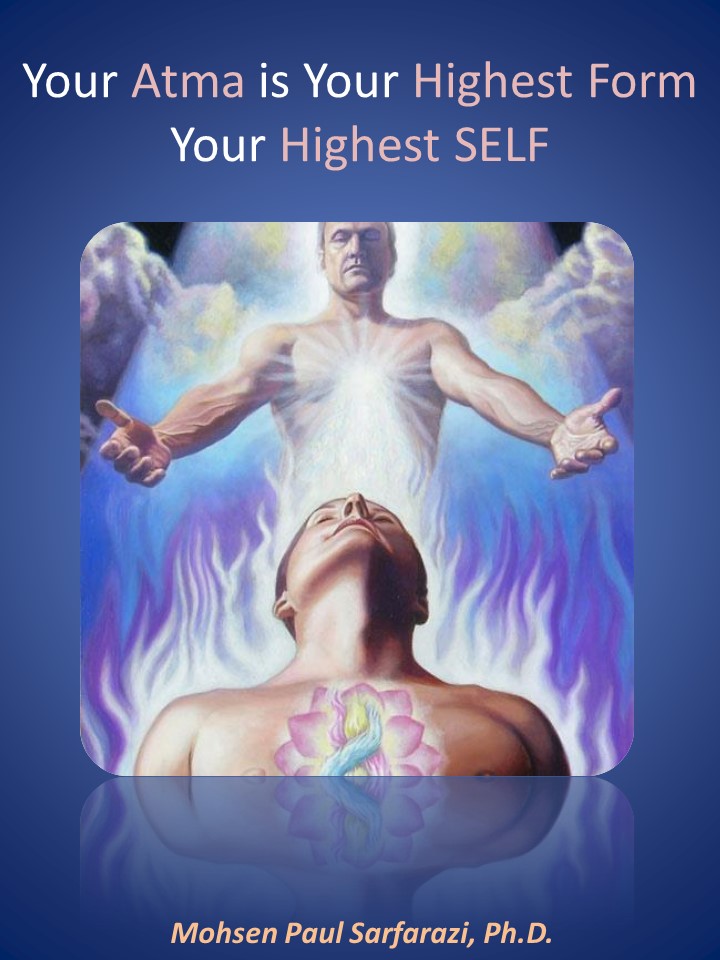Written by Frank M. Lin on 10/23/2022 5:34 am – I feel a bit silly but this is in fact true. I’ve never heard of the word Atma until like 5 minutes ago. I saw Dr. Mohsen Paul Safarazi reference it below (see picture). Learn something new everyday!! I love it. Notice Atma is clearly explained in Buddhism. Pretty neat.

Source: https://en.wikipedia.org/wiki/%C4%80tman_(Hinduism) (click for much more extensive read)
Ātman (/ˈɑːtmən/; Sanskrit: आत्मन्) is a Sanskrit word that refers to the (universal) Self or self-existent essence of individuals, as distinct from ego (Ahamkara), mind (Citta) and embodied existence (Prakṛti).[note 1] The term is often translated as soul,[note 2] but is better translated as “Self,”[1] as it solely refers to pure consciousness or witness-consciousness, beyond identification with phenomena. In order to attain moksha (liberation), a human being must acquire self-knowledge (Atma Gyaan or Brahmajnana).
Atman is a central concept in the various schools of Indian philosophy, which have different views on the relation between Atman, individual Self (Jīvātman), supreme Self (Paramātmā) and, the Ultimate Reality (Brahman), stating that they are: completely identical (Advaita, Non-Dualist),[2][3] completely different (Dvaita, Dualist), or simultaneously non-different and different (Bhedabheda, Non-Dualist + Dualist).[4]
The six orthodox schools of Hinduism believe that there is Ātman in every living being (jiva), which is distinct from the body-mind complex. This is a major point of difference with the Buddhist doctrine of Anatta, which holds that in essence there is no unchanging essence or Self to be found in the empirical constituents of a living being,[note 3] staying silent on what it is that is liberated.[5][6][7][8]
In Hinduism, Atman refers to the self-existent essence of human beings, the observing pure consciousness or witness-consciousness as exemplified by the Purusha of Samkhya. It is distinct from the ever-evolving embodied individual being (jivanatman) embedded in material reality, exemplified by the prakriti of Samkhya, and characterized by Ahamkara (ego, non-spiritual psychological I-ness Me-ness), mind (citta, manas), and all the defiling kleshas (habits, prejudices, desires, impulses, delusions, fads, behaviors, pleasures, sufferings and fears). Embodied personality and Ahamkara shift, evolve or change with time, while Atman doesn’t.[12] It is “pure, undifferentiated, self-shining consciousness.”[13]
As such, it is different from non-Hindu notions of soul, which includes consciousness but also the mental abilities of a living being, such as reason, character, feeling, consciousness, memory, perception and thinking. In Hinduism, these are all included in embodied reality, the counterpart of Atman.
Atman, in Hinduism, is considered as eternal, imperishable, beyond time, “not the same as body or mind or consciousness, but… something beyond which permeates all these”.[14][15][16] Atman is the unchanging, eternal, innermost radiant Self that is unaffected by personality, unaffected by ego; Atman is that which is ever-free, never-bound, the realized purpose, meaning, liberation in life.[17][18] As Puchalski states, “the ultimate goal of Hindu religious life is to transcend individually, to realize one’s own true nature”, the inner essence of oneself, which is divine and pure.[19]
